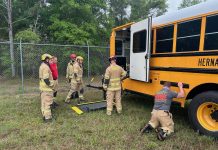A common theme runs through conversations about special needs transportation for Head Start through high school: Build on good community relationships that lead to successful mobility. The earlier the preparation, the easier it should be when it comes time to obtain funding or become compliant.
School transportation professionals had intensive discussions about special needs transportation during workshops at the STN EXPO in July. Workshops in special needs and Head Start tracks included the basics of driver training and monitoring, transportation health and safety, accountability on the bus, safety restraints and cost-benefit analysis for deciding on transportation services.
The lessons shared are filtering into communities, as the industry prepares for upcoming wheelchair restraint regulation deadlines.
Wheelchair Standard Countdown
There’s a new standard, called WC18, going into effect in December 2015 that will help transporters safely secure wheelchairs in commercial vehicles servicing Head Start through high school students.
Leading up to the due date, advocates urge wide communication, training for safely securing special needs students on buses and wise purchasing decisions for compliant wheelchair equipment. Another recommendation is to work closely with the special education staff to ensure proper equipment and procedures.
“It’s only with this intimate working relationship that you uncover problems. When it comes to getting a wheelchair compliant, it can only happen when it’s newly ordered. There’s no retrofit. It’s important to have this kind of communication. You need to have good positive discussions,” said Sue Shutrump, NAPT’s Special Needs committee chair.
For example, a therapist may recommend and order a new wheelchair every five years, but he or she may not know about vehicle transport procedures. Funding could go to equipment that isn’t compliant for school bus transportation requirements.
“Therapists need training as much as a new special needs bus driver. If they don’t know, they won’t know what to purchase. Most kids are transported privately, but when the rider uses public buses, everyone needs to know,” added Shutrump, who in her main job supervises occupational and physical therapy for Trumbull County (Ohio) Educational Service Center.
The center, with 22 therapists, continuously performs training and provides a checklist for wheelchair tie-downs. In addition, the team takes photos of different wheelchairs in place, so the tie-downs can be properly replicated each time. Shutrump noted it all makes a big difference.
When it comes to ordering special needs equipment, intermediary wheelchair vendors may assume the staff already has enough knowledge about student transportation. Be sure vendors are familiar with wheelchair and seating manufacturers, as well as tie down manufacturers specializing in WC19 and WC18 standards, she added.
Head Start Looking Ahead
Another key conversation focuses on leveraging transportation to get the best value for Head Start special needs students, which should account for at least 10 percent of enrollment.
As federal funding for education programs becomes more competitive, Head Start directors struggle to pare costs, often leading to transportation cuts rather than reducing the number of children served or downsizing staff.
When applying for funding, a cost-benefit analysis is beneficial. Also, meeting transportation standards for special needs students can make a difference in getting funding or not. Transportation is not a Head Start requirement, so it’s taken into account positively during the application process.
“Sometimes it’s the reason why some programs get awards over others,” said Nancy Netherland, a Head Start consultant and STN EXPO speaker.
Head Start leaders who want to contract private bus services should be sure the drivers and equipment are up-to-date in standards for special needs passengers, especially those in wheelchairs, as well as the proper use of lap-shoulder seat belts and any necessary car seats or integrated child seats for preschoolers as well as toddlers. Careful budget planning can help ease unforeseen problems.
“Every change goes into the Head Start world. When regulations change, it rolls through Head Start with a price tag,” added Netherland.
Partnerships that Pay Off
Leveraging relationships with public school transportation departments also could bring value to Head Start programs.
A good example is the Longview Public School District in Washington, where the transportation department has joint services for Head Start and special needs students within the general population. The district designates nine vehicles for Head Start, and all are compliant for special needs.
“Public partnerships are the way to go,” said Transportation Director Rick Lecker, who presented Head Start workshops at the 2014 STN EXPO.
He explained regulation isn’t a huge challenge for the district’s Head Start programs, because the transportation department stays on top of changes for all passengers.
Other Trends Ahead
What’s next for special needs transportation?
Manufacturers are looking at other parts of the world and emerging issues in the public transportation world, where speed is the essence of the service.
“Transit systems are pressed to stay on time, and they need to get people in and out of the vehicle faster. Next will be restraint systems that allow more speed of wheelchair installation. It will likely come to the school bus industry,” said Aaron Acton, who is a product line manager at IMMI, which is known for its SafeGuard line of school bus seats, restraint systems and testing.
















